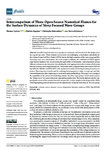Intercomparison of Three Open-Source Numerical Flumes for the Surface Dynamics of Steep Focused Wave Groups
| dc.contributor.author | Vyzikas, T | |
| dc.contributor.author | Stagonas, D | |
| dc.contributor.author | Maisondieu, C | |
| dc.contributor.author | Greaves, Deborah | |
| dc.date.accessioned | 2021-01-03T19:07:31Z | |
| dc.date.available | 2021-01-03T19:07:31Z | |
| dc.date.issued | 2020-12-30 | |
| dc.identifier.issn | 2311-5521 | |
| dc.identifier.issn | 2311-5521 | |
| dc.identifier.other | 0 | |
| dc.identifier.uri | http://hdl.handle.net/10026.1/16775 | |
| dc.description.abstract |
<jats:p>NewWave-type focused wave groups are commonly used to simulate the design wave for a given sea state. These extreme wave events are challenging to reproduce numerically by the various Numerical Wave Tanks (NWTs), due to the high steepness of the wave group and the occurring wave-wave interactions. For such complex problems, the validation of NWTs against experimental results is vital for confirming the applicability of the models. Intercomparisons among different solvers are also important for selecting the most appropriate model in terms of balancing between accuracy and computational cost. The present study compares three open-source NWTs in OpenFOAM, SWASH and HOS-NWT, with experimental results for limiting breaking focused wave groups. The comparison is performed by analysing the propagation of steep wave groups and their extracted harmonics after employing an accurate focusing methodology. The scope is to investigate the capabilities of the solvers for simulating extreme NewWave-type groups, which can be used as the “design wave” for ocean and coastal engineering applications. The results demonstrate the very good performance of the numerical models and provide valuable insights to the design of the NWTs, while highlighting potential limitations in the reproduction of specific harmonics of the wave group.</jats:p> | |
| dc.format.extent | 9-9 | |
| dc.language | en | |
| dc.language.iso | en | |
| dc.publisher | MDPI AG | |
| dc.title | Intercomparison of Three Open-Source Numerical Flumes for the Surface Dynamics of Steep Focused Wave Groups | |
| dc.type | journal-article | |
| dc.type | Journal Article | |
| plymouth.issue | 1 | |
| plymouth.volume | 6 | |
| plymouth.publisher-url | https://www.mdpi.com/2311-5521/6/1/9 | |
| plymouth.publication-status | Published online | |
| plymouth.journal | Fluids | |
| dc.identifier.doi | 10.3390/fluids6010009 | |
| plymouth.organisational-group | /Plymouth | |
| plymouth.organisational-group | /Plymouth/Faculty of Science and Engineering | |
| plymouth.organisational-group | /Plymouth/Faculty of Science and Engineering/School of Engineering, Computing and Mathematics | |
| plymouth.organisational-group | /Plymouth/PRIMaRE Publications | |
| plymouth.organisational-group | /Plymouth/REF 2021 Researchers by UoA | |
| plymouth.organisational-group | /Plymouth/REF 2021 Researchers by UoA/UoA12 Engineering | |
| plymouth.organisational-group | /Plymouth/Research Groups | |
| plymouth.organisational-group | /Plymouth/Research Groups/Marine Institute | |
| plymouth.organisational-group | /Plymouth/Users by role | |
| plymouth.organisational-group | /Plymouth/Users by role/Academics | |
| plymouth.organisational-group | /Plymouth/Users by role/Researchers in ResearchFish submission | |
| dcterms.dateAccepted | 2020-12-18 | |
| dc.rights.embargodate | 2021-1-7 | |
| dc.identifier.eissn | 2311-5521 | |
| dc.rights.embargoperiod | Not known | |
| rioxxterms.versionofrecord | 10.3390/fluids6010009 | |
| rioxxterms.licenseref.uri | http://www.rioxx.net/licenses/all-rights-reserved | |
| rioxxterms.licenseref.startdate | 2020-12-30 | |
| rioxxterms.type | Journal Article/Review |


